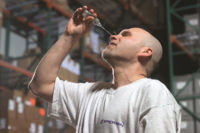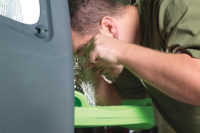
If the emergency eyewash at your worksite could decrease the number of emergency room visits, reduce the severity of injuries, ensure fewer lost days at work, improve compliance and allow you to immediately recharge or refill used stations, would you do it?
Chances are the answer is yes.
That is exactly what Kawasaki Rail Car did 14 months ago when it revamped its approach to emergency eyewash by installing portable, sterile stations containing sterile solution.

Joe Infantolino
Eyes at risk
Kawasaki Rail Car, based in Yonkers, N.Y., manufactures parts for and assembles railroad cars, primarily for passenger trains. With three buildings and a test track spanning a combined 450,000 square feet, many of its workers perform hazardous tasks such as metal cutting, grinding, sandblasting and painting. Eye injuries rank among the top five types of injuries incurred on the job, averaging fewer than ten per year. Considering the potential long-term impact of an eye injury, including blindness or the loss of an eye, Kawasaki takes such injuries extremely seriously and employs a vigorous safety program to ensure the best protection and first aid care for its workers.Joe Infantolino, safety and health administrator at Kawasaki Rail Car, oversees all aspects of the company’s safety programs. This includes meeting ANSI and OSHA safety requirements, training workers on safety equipment, and managing a staff of eight first responders, who are trained and equipped similarly to an EMT. One of Infantolino’s many responsibilities is ensuring his facility meets national requirements for proper installation, training, use and maintenance of its emergency eyewash stations; a task formerly so involved that it was handled by an outsourced vendor.
Sixty workers at Kawasaki Rail Car wear full face shields combined with primary eye protection on a daily basis. Yet still, the majority of eye injuries are caused by flying debris. For example, Kawasaki has a large number of workers who perform grinding operations. When machining metal parts, they are also responsible for deburring — or grinding the edges off — those products, which poses an eye hazard and therefore requires that emergency eyewash be located nearby. In fact, many locations of the facility require emergency eyewash: the warehouse’s forklift charging areas; the manufacturing section’s grinding and acid etching areas; the subassembly area for welding; two paint booths where both paints and solvents are present; and the sandblast area.
The switch to portable
In March 2008, Kawasaki Rail Car replaced its existing system of emergency eyewashes with ten new sterile portable stations. According to Infantolino, the results have been encouraging.First, the number of eye injuries requiring emergency room visits has dropped. In some cases, an injury that would have cost the company $1,200 for an emergency room and follow-up doctor visit now only costs a couple hundred dollars to replace the sterile eyewash cartridge. That is because the buffered, sterile saline solution matches the natural pH of human tears.
Also, in an environment such as Kawasaki’s where airborne particles commonly collect on equipment, keeping the treatment area clean is vital. The new sterile delivery system ensures that debris collecting on an eyewash station doesn’t enter the eye: the unit’s face pulls down to expose a completely sterile treatment area.
To help an injured worker complete a full 15-minute flush as required by ANSI, the new eyewash stations promote proper ergonomics and correct finger placement so an injured worker can hold both eyes open to avoid blinking, which can cause foreign particles to scrape and further damage the eye. An alarm sounds when a station is activated, alerting supervisors and first responders to the site immediately to provide follow-up care. And the stations’ visibility within Kawasaki Rail Car is much improved with new signage, helping workers identify units even from between aisles. Because they are sterile, easier to use and more visible, workers are able to reach treatment more quickly and even reduce the severity of some injuries. This translates into fewer hospital trips and lost days at work — and big healthcare savings.
Today, inspection of the units — which used to be frequent and tedious — is easy at Kawasaki Rail Car. A window on the unit allows a clear view in to the cartridge date, and the press of a button shows whether the station is functional. According to Infantolino, the units are easy to reset after they have been activated. Rather than wait for someone to come and service a unit, he keeps extra cartridges in stock and replaces them immediately so the unit is back in service the same day.
The right choice
Portable stations provide the flexibility Kawasaki needs, and can be moved via a pushcart to be within a 10-second walk of any eye hazard, per ANSI’s requirement.Through its new approach to emergency eyewash, Kawasaki Rail Car has proven that — when combined with proactive steps to reduce risks and increase safety compliance — sterile, portable eyewash units allow it to achieve protection for one of its most common workplace injuries. The results: increased productivity, decreased healthcare costs, a safer work environment and unmatched care for the eyes — everyone’s windows to the world.

